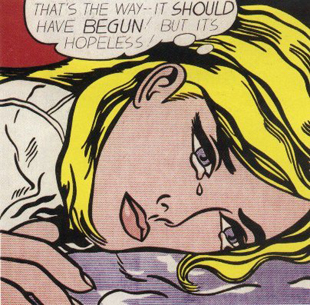Ben-day Dots

The Ben-day Dot printing process combines two (or more) different small, coloured dots to create a third colour. The process was named after US illustrator and printer Benjamin Day (1836-1916) who was the first to patent and sell "shading mediums" in 1879. which was an important tool in chromolithography and later in other kinds of commercial illustration. A flexible glue sheet, cast from the surface of a plate ruled widh parallel lines, was inked and then pressed over an image to shade it.
Depending on the effect required, colour and dots may be separate or overlapping. 1950s and 1960s pulp comic books used Benday dots to inexpensively create shading from spot colours. Roy Lichtenstein is well-known for his use of this method in his Pop art enlarged cartoon strip images.
(above image: Hopeless by Roy Lichtenstein in 1963)
|